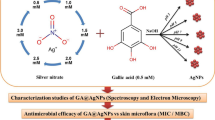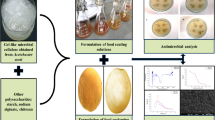Abstract
Desmotachya bipinnata L. (Darbha) is a tropical grass used as an inevitable material in traditional practices and rituals of the Indian Hindus. Darbha, the sacred grass has been used to prevent spoilage of fermentable food during solar and lunar eclipses, which is being followed even today. However, the reason for choosing this grass among several other grass species has not been reported. In this work, while exploring the reason behind the choice of this grass for traditional practices, interesting hierarchical nanoscale morphology of Darbha grass revealed in scanning electron microscopy. To understand the role of Darbha in food preservation during eclipse, cow’s curd has been chosen a representative fermentable food item. Systematic investigation on Darbha grass grown in three different microhabitats has been performed, and their effect on the population and diversity of lactobacilli from cow’s curd has been studied. Interestingly, the grass with the most prominent nanoscale features is found to remove most of the lactobacilli from cow’s curd. Thus, Darbha reduces microbial accumulation in fermentable food items when the bactericidal ultraviolet and blue radiations are not available to the earth surface during eclipse. The disinfecting ability of Darbha is compared with five other tropical grasses chosen on the basis of presence/absence of micro/nanofeatures, antibacterial effect and hydrophobic surface. The other grasses used in this study are Chloris Barbata L., Apluda aristata L., Cynodon dactylon L., Bamboosa arundinacae L. and Cymbopogon citratus L. Based on comparative studies with these grasses, the mechanism of disinfecting ability of Darbha is attributed mainly to the hierarchical micro/nanofeatures present on the grass surface. The results of the present investigation could be used to design novel biomimetic antibacterial surfaces for applications including health care.





Similar content being viewed by others
References
Vigneron, J. P., Rassart, M., Vertesy, Z., Kertesz, K., Sarrazin, M., Biro, L. P., et al. (2005). Optical structure and function of the white filamentary hair covering the edelweiss bracts. Physical Review E, 71, 011906.
Pillai, V. K., & Parthasarathy, M. (2012). Functional materials: A chemist’s perspective. India: Universities Press (India) –IIM series.
Barthlott, W., & Neinhuis, C. (1997). Planta, 202, 1.
Parthasarathy, M., Brindha, P., Ravichandran, N., Saralla, R. P., Jayaraman, P. (2014). Bioelectrochemistry in press.
Mahdihassan, S. (1987). Three important Vedic grasses. Indian Journal of History of Science, 22, 286.
Council of Scientific & Industrial Research (2003) The wealth of India: a dictionary of Indian raw materials and industrial products. New Delhi. 343.
Council of Scientific & Industrial Research (2001) The wealth of India: a dictionary of Indian raw materials and industrial products New Delhi 5:169.
Gamble, J. S. (1997). Flora of the Presidency of Madras. London: west Newman and Adlard.
Mathew, K. M. (1981). Materials for a flora of the Tamilnadu Carnatic. Tiruchirappalli: St. Joseph’s College.
Harborne, J. B. (1984). Phytochemical methods: A guide to modern techniques of plant analysis. New York: Chapman and Hall.
Jordon, T. N. (1981). Effects of diluents volumes and surfactants on the phytotoxicity of glyphosate to bermudagrass. Weed Science, 29, 79.
Bhargavi, S., Naresh, M., Batsala, M., Suryasagar, G., Nama, S. (2013). An evaluation of the antibacterial properties of the root extracts of Chloris barbata Sw. against Staphylococcus aureus 9886 and Escherichia coli 1673. International Journal of Biopharma Research, 02(04), 127.
Ewansiha, J. U., Garba, S. A., Mawak, J. D., Oyewole, O. A. (2012). Antimicrobial activity of Cymbopogon Citratus and its phytochemical properties. Frontiers in Science, 2(6), 214.
Zhang, J., Gong, J., Ding, Y., Lu, B., Wu, X., Zhang, Y. (2010). Antibacterial activity of water phase extracts from bamboo shavings against food spoilage microorganisms. African Journal Biotechnology, 9(45), 7710.
Vermeulen, N., Keeler, W. J., Nandakumar, K., Leung, K. T. (2008). The bactericidal effect of ultraviolet and visible light on Escherichia coli. Biotechnology and Bioengineering, 99, 550.
Lipovsky, A., Nitzan, Y., Gedanken, A., Lubart, R. (2010). Visible light-induced killing of bacteria as a function of wavelength: implication for wound healing. Lasers in Surgery and Medicine, 42, 467.
Jahed, Z., Lin, P., Seo, B. B., Verma, M. S., Gu, F. X., Tsui, T. Y., et al. (2014). Responses of Staphylococcus aureus bacterial cells to nanocrystalline nickel nanostructures. Biomaterials, 35, 4249.
Elberse, W. T., & Berendse, F. (1993). Eight grass species from habitats with different nutrient availabilities. Functional Ecology, 7, 223.
Al Haj Khaled, R., Duru, M., Theau, J. P., Plantureux, S., Cruz, P. (2005). Variation in leaf traits through seasons and availability levels and its consequences for ranking grassland species. Journal of Vegetation Science, 16, 391.
Natasa, M. D., Wang, J., Mocanasu, R. D., Stoddart, P. R., Crawford, R. J., Ivanova, E. P. (2008). Impact of nano-topography on bacterial attachment. Biotechnology Journal, 3, 536.
Sengupta, R., Altermann, E., Anderson, R. C., McNabb, W. C., Moughan, P. J., Roy, N. C. (2013). The role of cell surface architecture of lactobacilli in host-microbe interactions in the gastrointestinal tract. Mediators of Inflammation. Article ID 237921, 16 pages.
Singh, A. V., Vyas, V., Patil, R., Sharma, V., Scopelliti, P. E., Bongiorno, G., et al. (2011). Quantitative characterization of the influence of the nanoscale morphology of nanostructured surfaces on bacterial adhesion and biofilm formation. Plos One, 6, 25029.
Ma, J., Sun, Y., Gleichauf, K., Lou, J., Li, Q. (2011). Nanostructure on taro leaves resists fouling by colloids and bacteria under submerged conditions. Langmuir, 27, 10035.
Alba, L. D., Jones, D. N., Badawy, H. T., Eliason, C. M., Shawkey, M. D. (2014). Antimicrobial properties of a nanostructured eggshell from a compost-nesting bird. The Journal of Experimental Biology, 217, 1116.
Donlan, R. M. (2008). Biofilms: microbial life on surfaces. Emerging Infectious Diseases, 8, 881.
Sengupta, R., Altermann, E., Anderson, R. C., McNabb, W. C., Moughan, P. J., Roy, N. C. (2013). The role of cell surface architecture of lactobacilli in host-microbe interaction in the gastrointestinal tract. Mediators of Inflammation, Article ID 237921, 16 pages.
Patil, M. M., Paul, A., Anand, T., Ramana, K. V. (2010). Isolation and characterization of lactic acid bacteria from curd and cucumber. Indian Journal Biotechnology, 9, 166.
Cannon, J. P. (2005). Pathogenic relevance of lactobacillus: a retrospective review over 200 cases. European Journal of Clinical Microbiology and Infectious Diseases, 24, 31.
Jucker, B. A., Zehnder, A. J. B., Harms, H. (1998). Quantification of polymer interactions in bacterial adhesion. Environmental Science and Technology, 32, 2909.
Li, Q., Mahendra, S., Lyon, D. Y., Brunet, L., Liga, M. V., Li, D., et al. (2008). Antimicrobial nanomaterials for water disinfection and microbial control: potential applications and implications. Jornal of Water Research, 42, 4591.
Acknowledgments
Authors acknowledge infrastructural and funding support from SASTRA University for carrying out this work.
Compliance with Ethical Standards
• We hereby confirm that the work presented in this report has not been published before and is not under consideration for publication anywhere else.
• We also confirm that the work has been approved by all the co-authors as well as by the responsible authorities of the University.
• The authors declare that there is no conflict of interest.
• There are no human or animal models used in this study.
Author information
Authors and Affiliations
Corresponding author
Electronic Supplementary Material
Below is the link to the electronic supplementary material.
ESM 1
(DOCX 11 kb)
Rights and permissions
About this article
Cite this article
Raj, D.S., Sushmetha, A.M., Jayashree, S. et al. Hierarchical Nanofeatures Promote Microbial Adhesion in Tropical Grasses: Nanotechnology Behind Traditional Disinfection. BioNanoSci. 5, 75–83 (2015). https://doi.org/10.1007/s12668-015-0164-y
Published:
Issue Date:
DOI: https://doi.org/10.1007/s12668-015-0164-y




